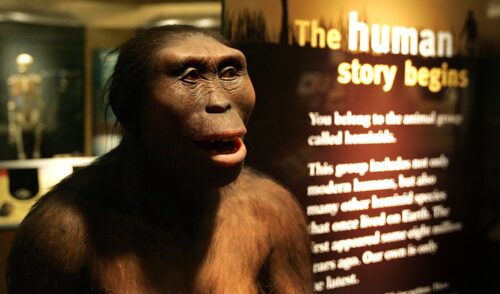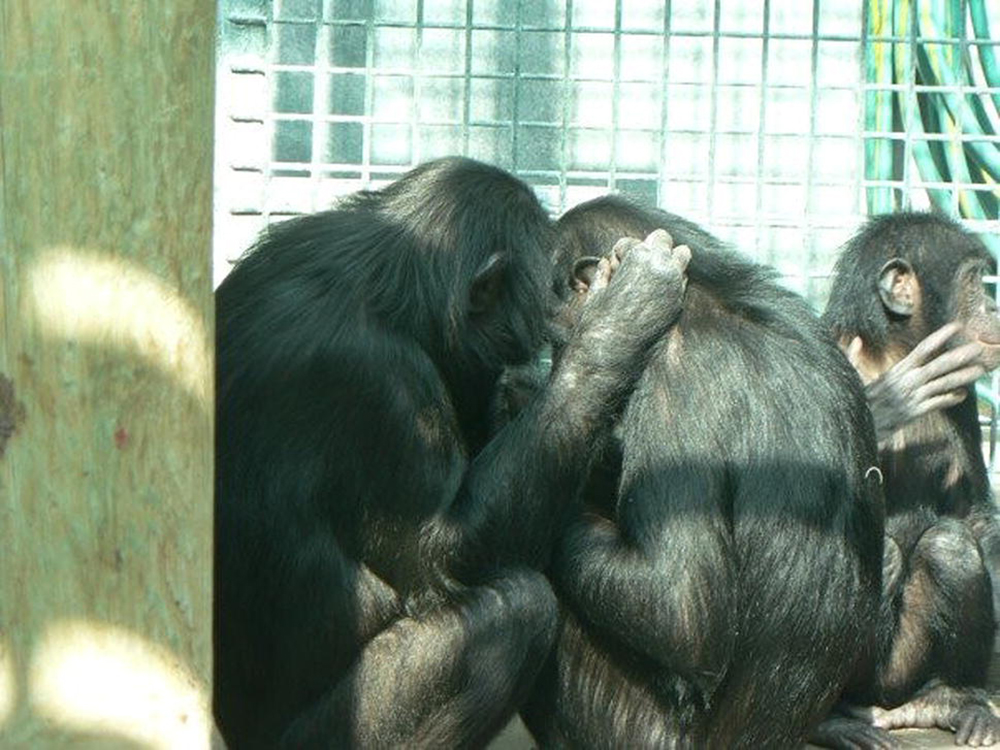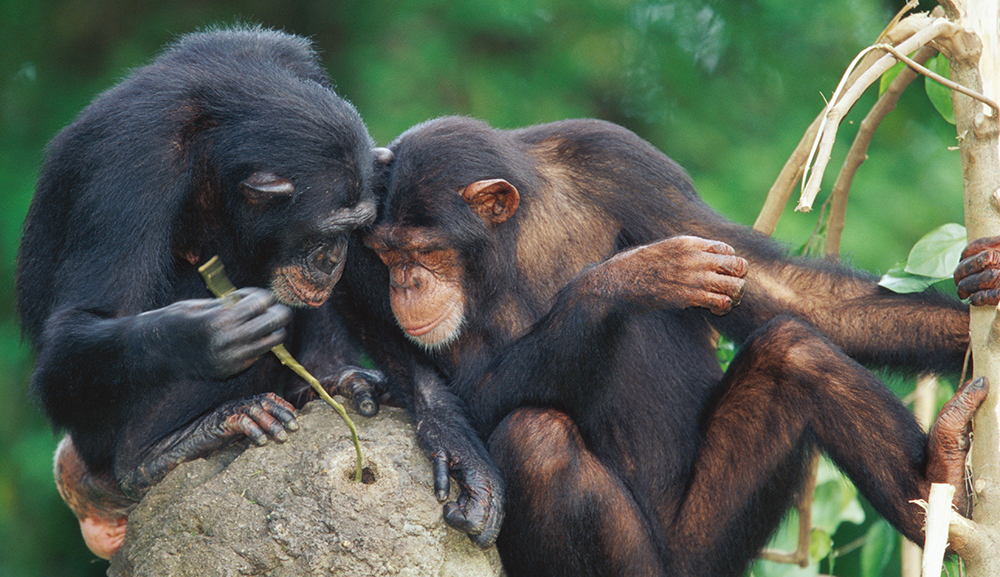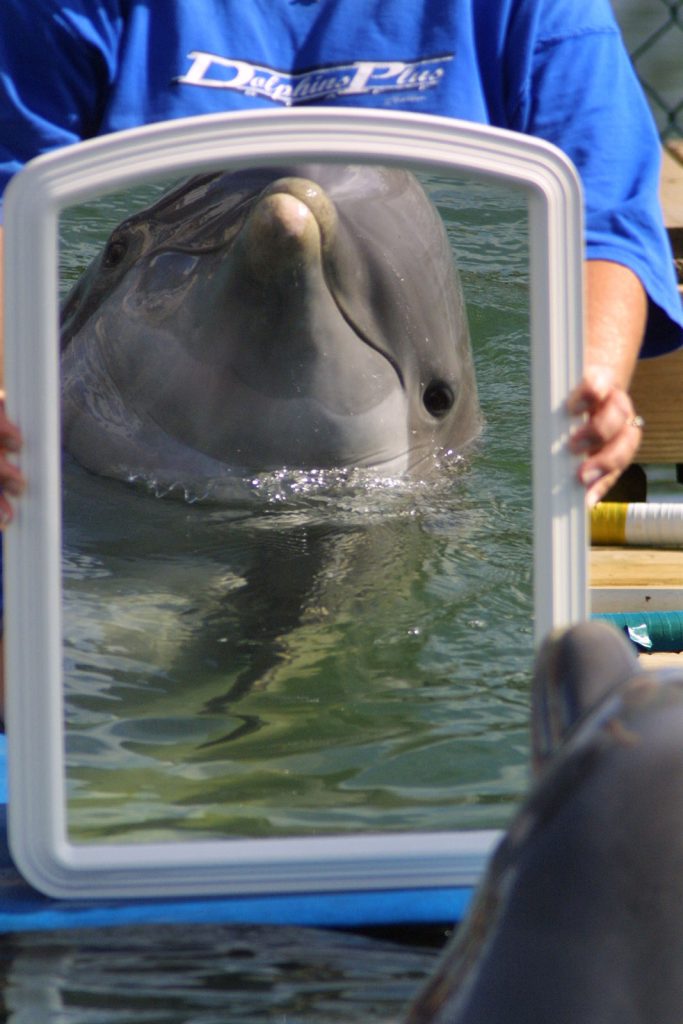Is Gender Unique to Humans?
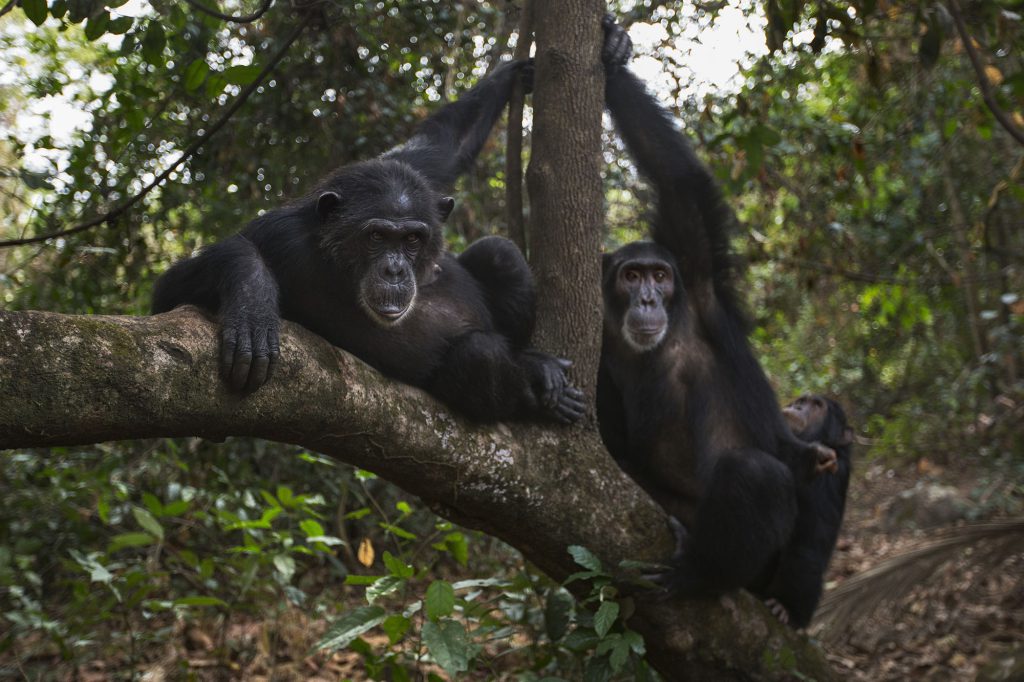
This summer, in the introductory course I teach on the evolution and biology of human and animal behavior, I showed my students a website that demonstrates how to identify frog “genders.” I explained that this was a misuse of the term “gender”; what the author meant was how to identify frog sexes. Gender, I told the students, goes far beyond mere sex differences in appearance or behavior. It refers to something complex and abstract that may well be unique to Homo sapiens. This idea is nothing new; scholars have been saying for decades that only humans have gender. But later that day I began to wonder: Is it really true that gender identity is totally absent among nonhuman species—even our closest evolutionary relatives, chimpanzees and bonobos?
Before tackling this question, it is necessary to define “sex” and “gender.” Sex refers to biological traits associated with male and female bodies. Sex isn’t a perfect binary, but it is relatively simple compared to gender.
Gender is multifaceted, complex, and a little abstract, and not everyone agrees on exactly what it means. That said, there are a couple of aspects of gender that most experts say are essential. The first is the existence of socially determined roles. Gender roles refer to the range of behaviors that society deems normal or appropriate for people of a particular gender based on their designated sex—the norms that (at least in many Western cultures) cause us to expect men to be assertive and brave, and women to be caring and accommodating, for instance.
It’s common for people to believe that gender roles are natural or innate, ranging from religious claims that they are God-given to the argument made by evolutionary psychologists that they are the biological result of natural selection. On the contrary, while some aspects of gender-correlated behaviors are probably largely genetic in origin (researchers don’t have a great sense of which are and aren’t), most experts agree that many gender-related expectations, such as that girls play princess and boys pretend to be soldiers, are socially determined—that is, we learn them from our culture, often without even being aware of it. This socially learned aspect is as fundamental to gender as the roles themselves.
Another fundamental aspect of gender is an internal sense of gender identity. Most people don’t just act in accordance with the roles associated with their gender identity, they also feel something inside of themselves that tells them what their gender is. For many, this sense of identity aligns with their biological sex (cisgender), but that’s not true for everyone. Plenty of people are biologically male, but they identify as women, or vice versa (transgender). Some individuals have a gender identity that is somewhere in between masculine and feminine, or it’s a mix of both or neither (androgyny). Still others are intersex, having both male and female biological traits; just like those who fit on either side of the sex spectrum, intersex people fall across a range of gender identities.
So, two criteria substantiate gender: socially determined roles and an internal sense of identity. Neither of these by itself is enough to fully encompass what gender is, but most experts appear to agree that each is a necessary aspect of gender. Therefore, to assess the common claim that gender is unique to humans, we need to look at how other species fare with respect to these two criteria.
This is a tough endeavor—most of what we know about human gender originated from talking to people, and we usually don’t have the ability to ask other species what they think. Nonetheless (as I’ve written about before on the topic of primate vocal communication), we do have some access to animals’ minds through observing their social behavior. The evidence accrued from numerous studies, while not decisive, shows that gender might, in fact, exist in other species.
First, let’s look at the question of socially determined roles. Plenty of nonhuman species show sex-based differences in behavior. From beetles to gorillas, males of many species are more aggressive than females, and they fight with one another for access to resources and mating opportunities. Males are also often the more flamboyant sex, using showy body parts and behaviors to attract females—for example, take the peacock’s tail, the mockingbird’s elaborate song, or the colorful face of the mandrill (think Rafiki from The Lion King). Females, on the other hand, are in many cases more nurturing of offspring than males; after all, by the time an infant is born the female will have already devoted significant time and energy toward forming, laying, and subsequently protecting and incubating her eggs—or, in the case of us mammals, she has gone through an intense process of gestation. The costly nature of reproduction for females limits the number of infants they can have; that’s why it generally behooves females to be conservative, expending their time and energy on mating with only the highest-quality males. Being choosy in this way has, over evolutionary time, generally yielded fitter offspring. As a result, females of many species have evolved to be the choosier sex, and their mate choices can direct the course of evolution (an idea that scandalized Victorian England when first proposed by Charles Darwin).
There are exceptions to every rule, of course. Male seahorses get pregnant. Female spotted hyenas dominate males and sport a pseudo-penis (enlarged clitoris) that is capable of erection and can be as much as 90 percent the size of a male’s penis. As matriarchal as spotted hyena society is, it doesn’t quite reach the level of the northern jacana, a wading bird species whose common territory ranges from Panama to Mexico. Female northern jacanas patrol a territory full of males and fight off intruding females; the smaller males engage in less territorial behavior than females, instead spending that time caring for a nest full of the resident female’s eggs.
Turning to our closest relatives, chimpanzees and bonobos, we see additional illustrative examples of the natural variation that exists in sex-correlated behavior. Although the two species are 99.6 percent genetically identical (and equidistant from humans), they are quite different. In general, adult male chimpanzees, like males of many species, are aggressive, domineering, and status-seeking. Much of their time is spent either patrolling territorial boundaries to deter or even kill members of other communities, or vying for social power within their own group. Adult females are generally less political and less violent—they have other priorities, like caring for offspring—but they can still influence the state of social affairs by breaking up male fights or leading rival males to reconcile. After all, as is the case in many species, much of what males stand to gain from high status is access to mating opportunities with females.
It’s been said that if chimpanzees are from Mars, then bonobos are from Venus. Bonobo society is generally female-dominated. Unlike female chimpanzees who mostly, though not always, keep their noses out of politics, female bonobos reign by forming male-dominating coalitions. They bond partly through genito-genital rubbing (it is what it sounds like), forming stronger relationships than female chimps typically have with one another. As for male bonobos, they are much less violent on average than male chimps. Unlike with chimpanzees, lethal aggression has never formally been observed in bonobos (though there has been one suspected instance); bonobos are more likely to share food (and maybe sex) with a stranger than to fight.
Some scholars look at the sex differences in behavior described in the above paragraphs as clear examples of nonhuman gender. But none of the evidence I have covered so far proves that behavioral differences between male and female chimpanzees, bonobos, or other nonhuman species are socially determined. Again, gender necessarily entails socially determined roles. Do we have any evidence that chimp and bonobo behaviors are determined socially rather than biologically?
That is the question Michelle Rodrigues, a postdoctoral researcher at the University of Illinois, and Emily Boeving, a doctoral candidate in psychology at Florida International University, set out to answer. They found that there is flexibility in some of the sex roles previously observed in chimpanzees and bonobos—specifically, in grooming. In both chimpanzees and bonobos (as well as in many other primates), grooming serves as a way of strengthening social bonds. In the wild, most of the grooming in both species is male-on-female or vice versa. Where the species differ is that among wild chimpanzees, male-male grooming is generally more common than female-female grooming—an imbalance not seen in bonobos.
Rodrigues and Boeving wondered whether chimps and bonobos living at zoos would show the same grooming patterns. To investigate this, they observed chimpanzees and bonobos at the North Carolina Zoo and Columbus Zoo, respectively, paying special attention to grooming networks. In contrast to data from the wild, zoo-living apes’ grooming seemed to be more related to individuals’ histories and personalities than their sex: Neither species showed the sex-typical grooming patterns displayed by their wild counterparts.
This is solid evidence that certain sex roles are at least partly environmentally determined in these species. But is environmental determination the same as social or cultural determination? Not exactly. Social learning could be responsible for the flexibility we see in chimpanzee and bonobo sex roles. In this hypothetical scenario, wild female chimpanzees groom less than males because growing up, they receive less grooming from other females, and they witness little, if any, female-female grooming. They are socialized in these ways not to spend as much time grooming. In the zoo, then, the “culture” around grooming is atypical, and females are socialized differently. However, an equally plausible (but not mutually exclusive) possibility is that sex-based behavioral differences in the wild are simply the result of individuals finding ways of coping with their environment: Females in the wild have the responsibility of infant care. As a result, they are too busy foraging to spend much time socializing. At the zoo, with humans providing food, females groom more simply because they have the extra time—no social learning of sex roles is required.
Again, these two explanations are not mutually exclusive. Both could play a part. I spoke with Rodrigues about what evidence would be necessary to conclude that chimpanzee or bonobo sex roles were socially determined.
“We would need to see evidence that adults are actively treating male and female infants and juveniles differently, and actively [socializing] them differently,” she said. Rodrigues pointed out that some chimpanzee behavior is suggestive of different treatment of male and female offspring: For example, she noted, “data on young chimpanzees indicates that female chimpanzees spend more time observing their mothers termite-fishing and, in turn, are able to master termite-fishing using their mother’s technique at a younger age.” Researchers aren’t certain whether this is due to active socialization by mothers or an innate preference among female offspring to observe their mothers’ techniques. Even so, this observation is consistent with the idea of social determination of at least some, but probably not all, sex roles in chimps.
Flexibility in chimpanzee sex roles is not limited to the grooming patterns discussed earlier. Females occasionally participate in males’ political coalitions or go ranging with a mostly male group. Likewise, some males seem to prefer ranging with smaller groups of mostly females, or they spend more time interacting with infants than is typical for males. But scientists generally don’t consider this evidence of chimpanzee gender-bending. Rodrigues told me female-like behavior by male chimps is usually interpreted as a result of low rank—it’s not that the males prefer these feminine roles, it’s that they are relegated to these positions by dominant males.
“But,” Rodrigues said, “it may be that our existing frameworks for interpreting behavior are too focused on paternity and rank. I think one of the challenges in interpreting behavior is that our own social constructions color how we theorize and interpret data.”
(Now, you may be thinking, “What about bonobos?” Most of the evidence bearing on these questions comes from chimpanzees, who have been studied much more extensively than bonobos. That said, despite their many differences in behavior, chimpanzees and bonobos are still very closely related, and their cognitive capacities are likely very similar. If one species has something like gender, the other probably does too.)
So far, it’s not inconceivable that chimpanzees and bonobos might have something akin to human gender. But we haven’t yet touched on the other crucial criterion for gender: an internal, mental construct. How, if at all, do nonhuman animals think about sex and social roles? Scientists get at this question using cognitive testing—specifically, by testing animals’ concepts.
In psychology, “concepts” refer to mental categories. Round shapes vs. sharp shapes, light colors vs. dark colors, males vs. females—these are all concepts. Scientists have tried-and-true methods for getting at animals’ concepts, the most common being the match-to-sample testing paradigm: An animal is presented with a “sample” image, and then they must select the “matching” image among other options in order to receive a reward. For example, an animal might see a sample image of a female, then be rewarded for choosing a subsequently presented image of a female from alongside an image of a male. If the animal can learn to succeed at this task, it suggests that they possess a concept of “female.” This concept is, again, a mental category that allows the animal to recognize that some images depict a female and others don’t. In a few studies (like this one, this one, and this one) using this technique, monkeys have displayed concepts of male and female. In a similar study, where chimpanzees learned to match faces of individuals they knew to generic images of male and female behinds, the authors went so far as to call their findings evidence of a “gender construct.”
These studies are telling, but they’re not entirely conclusive. The subjects could have a full-blown, human-like concept of sex, but looking only at these tests, it’s also possible that the animals are simply learning to categorize images based on distinguishing features. Just as a sommelier learns to recognize different wines based on tannins, sweetness, and mouthfeel, subjects might be learning to recognize images of males and females based on depicted genitals, face shape, and body size rather than any social concept of the sexes.
Luckily, we don’t have to rely solely on cognitive testing; we can and should interpret the results of these tests in the context of natural social behavior in which there are plenty of examples of individuals seeming to distinguish between male and female groupmates. Alone, either of these lines of evidence—social behavior or cognitive tests—would be ambiguous, but taken jointly, they strongly suggest that chimpanzees have concepts of “male” and “female,” and, like humans, categorize individuals they know according to these concepts.
These concepts around the sexes are certainly an important part of gender, but they don’t equal a sense of gender identity—humans take these sex concepts and go further by applying them to how they think about themselves. Do our closest relatives do this? Direct evidence on this question is lacking, but some of the cognitive abilities that chimpanzees and bonobos have shown in unrelated contexts suggest that it’s possible.
Here it’s prudent to consider whether chimpanzees and bonobos have any sense of identity—or sense of self—at all. To find out, scientists have tested “mirror self-recognition”: the ability to recognize oneself in the mirror. As you might guess, chimpanzees and bonobos (along with other apes, dolphins, elephants, and some other nonhumans) show this ability, quickly realizing that the image in the mirror is a reflection of themselves and using the mirror to inspect their appearance. Scientists view this as evidence that an individual possesses an understanding of itself as an entity separate from the rest of the world. This understanding can be regarded as the foundation of a potential sense of gender identity.
A second question is: Do chimpanzees and bonobos understand that others are independent “selves” with their own internal mental lives? This understanding is really a set of abilities, collectively referred to as “theory of mind.” Chimp theory of mind is more controversial than mirror self-recognition, but the consensus view is that chimpanzees do possess this understanding, albeit probably not as fully as humans. (Again, because chimpanzees and bonobos are so closely related and have shown no major differences in cognitive abilities, we can assume the same is true of bonobos.)
So, chimpanzees and bonobos possess a sense of self and seem to understand that others, like them, have internal mental lives. And as we saw earlier, chimps seem to hold mental concepts of “male” and “female,” and categorize acquaintances accordingly. From there, I don’t think it’s implausible that chimps might apply those concepts not only to others but to their own sense of self. If—and this is a big if—that is the case, then chimpanzees possess sex roles that are not only flexible and potentially socially determined (as we saw earlier) but also tied to mental concepts that contribute to an individual’s sense of identity. If you ask me, that sounds a lot like gender.
It bears repeating that we lack direct evidence of an internal gender identity in chimpanzees, bonobos, and other nonhuman animals. But the question of gender in a nonhuman species has yet to be tackled in a comprehensive way, so perhaps a license to speculate a bit is warranted. If nothing else, it seems clear that gender in other species is entirely possible.
The more closely related two species are, the more likely it is that they share cognitive processes. And since chimpanzees and bonobos are our closest evolutionary cousins, the most scientifically sound approach may actually be to interpret ambiguous data as supporting, rather than challenging, the idea of human-like gender in our closest relatives. History has seen plenty of human-exceptionalist claims refuted. Much more research needs to be done, but in time, gender may turn out to be just one in a long list of attributes once thought to make humans unique.










